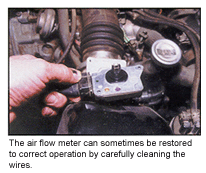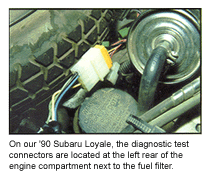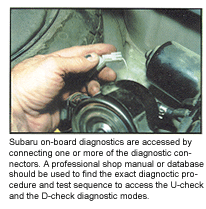When diagnosing hot-wire air flow meters (A/F meters) on Subarus and similarly equipped Asian vehicles, technicians may find that, while the meter passes all recommended test procedures, the engine exhibits driveability conditions associated with lean air/fuel mixture ratios. In these cases, it’s best to form a diagnostic strategy based on the relatively simple operating principles of the modern hot-wire A/F meter.
Unless otherwise noted, we’ll use diagnostic charts, trouble codes and component configurations that apply to a 1990 Subaru Loyale that is equipped with a 1.8L, throttle body fuel-injected engine and manual transmission. In most cases, these general diagnostic procedures can be used to troubleshoot suspected air flow meter faults on other nameplates equipped with hot-wire air flow sensors.
In order to diagnose fuel-related problems caused by faulty A/F meters, it’s very important to understand how the meter itself operates. The operating principles of hot-wire mass A/F meters are, on the surface, very simple. In the hot-wire system, an electrical current passes through a wire suspended in the engine’s intake air stream. As the engine runs, the wire is cooled by air flowing into the engine. As the wire cools, electrical resistance is reduced, which increases current flow through the wire. The A/F meter actually measures the increased current flowing through the wire and converts this measurement into a voltage signal that is sent to the PCM. The PCM then adjusts the pulse width of the fuel injector to correspond to the amount of air flowing into the engine.
 The operating strategy programmed into the PCM controls the functions and operational aspects of individual A/F meter applications. In most applications, the A/F meter is the primary authority for controlling the air/fuel mixture ratio. In contrast, the oxygen sensor may act as a fuel trim device and occasionally as a diagnostic device for relaying major air/fuel ratio failures back to the PCM. Other sensors, such as the coolant temperature and throttle position sensors, also act as fuel ratio trim devices that, depending upon operating conditions, may not exceed the authority of the A/F meter.
The operating strategy programmed into the PCM controls the functions and operational aspects of individual A/F meter applications. In most applications, the A/F meter is the primary authority for controlling the air/fuel mixture ratio. In contrast, the oxygen sensor may act as a fuel trim device and occasionally as a diagnostic device for relaying major air/fuel ratio failures back to the PCM. Other sensors, such as the coolant temperature and throttle position sensors, also act as fuel ratio trim devices that, depending upon operating conditions, may not exceed the authority of the A/F meter.
Vacuum Leak Diagnosis
Several scenarios can affect mass air flow operation. Since hot-wire mass A/F meters are designed to measure even the smallest quantity of air flowing into an engine, it’s very important to detect and repair even the smallest vacuum leak in the air induction system. For purposes of illustration, let’s assume that air flows into a 1.8L engine at the rate of three grams per second at hot idle. If a small vacuum leak allows one gram per second of “false air” to flow into the engine, the A/F meter may inform the PCM that the engine is idling very slowly. The reduced voltage signal to the PCM will cause the PCM to reduce the injector pulse width. In turn, this will create a lean air/fuel condition in the engine that encourages a hesitation, stumble, and rough idle or intermittent stalling condition.
Vacuum leaks can be easily diagnosed by several methods. I believe the safest and easiest method is to use a modified mechanical stethoscope to listen for vacuum leaks throughout the system. To modify the stethoscope for locating vacuum leaks, replace the probe with a length of plastic hose or fuel line. Alternate methods include listening for a change in engine speed while spraying propane or aerosol carb cleaner around manifold and vacuum connections. The various brands of “smoke” machines are also very handy diagnostic aids to use when attempting to locate vacuum leaks at the manifold-to-cylinder head gasket, throttle body shaft, throttle body-to-manifold gasket and vacuum hoses.
Meter Contamination
Air flow meter contamination provides another scenario that usually involves a lean air/fuel ratio condition. As vehicle miles increase, small particles of debris accumulate on the sensor. This debris can range from oil vapor and dirt to even small particles of paper pulled from cheap filtering media. Although some hot-wire systems are designed to initiate a “burn-off” mode upon engine start-up  to clean debris from the wire, the wire may acquire a coating that tends to insulate it from the cooling effects of intake air. This insulating effect will cause the wire to operate at a higher temperature and will indicate to the PCM that less air is flowing into the engine than what is really the case. In response, the PCM reduces injector pulse width, which creates the lean air-fuel ratio condition.
to clean debris from the wire, the wire may acquire a coating that tends to insulate it from the cooling effects of intake air. This insulating effect will cause the wire to operate at a higher temperature and will indicate to the PCM that less air is flowing into the engine than what is really the case. In response, the PCM reduces injector pulse width, which creates the lean air-fuel ratio condition.
Off-the-Chart Diagnostics
Going specifically to the A/F meter diagnostic chart for a 1990 Loyale, you would see that there is a simple three-wire system consisting of a supply voltage wire (red), a ground wire (black) and a signal return wire (white). According to the chart, you should see a key-on, engine-off black-to-ground maximum resistance of 10 ohms, key-on red-to-ground minimum voltage of 10 volts, and white-to-black range of 0.1 to 0.5 volts.
At this point, I would suggest expanding upon the recommended test procedure to render a more accurate diagnosis. To illustrate, test the black ground wire by checking the voltage drop to battery (B-) ground. The voltage drop should preferably be around 50 millivolts (mV), but shouldn’t exceed 100 mV. If the voltage drop exceeds this spec, check the PCM ground and A/F meter to PCM wiring for loose or corroded connections. Although Subaru recommends testing the ground circuit resistance, keep in mind that ground circuits should be tested in a loaded, key-on condition that duplicates engine-operating situations.
Next, the Subaru diagnostic chart recommends blowing compressed air through the A/F meter while looking for a voltage increase on the white signal return wire and black ground wire. After this test, voltage should return to the specified no-flow range of 0.1 to 0.5 volts. The purpose of this test, obviously, is to determine if the A/F meter is sensitive to air flowing through the meter. If voltage at the white wire doesn’t increase proportionately to an increase in air flow, the meter is faulty. Although this test does indicate whether or not the A/F meter is working, it does not indicate the degree of accuracy with which it is measuring the actual air flow into the engine.
Scenario 1:
To expand upon the recommended diagnostic process even more, let’s take our basic knowledge of A/F meters and apply it to some real-life scenarios. Our first scenario is a 1990 2.2L Legacy with an intermittent stalling, bucking or jerking condition. Again, this is a no-code complaint related to a lean air/fuel ratio. A more thorough inspection proved that the air flow sensor connector had loosened due to improper wiring harness support.
When diagnosing any intermittent problem, it’s especially important to observe the condition of the wiring and connectors. Too often, after an engine has been repaired or replaced, a technician neglects to correctly install the engine wiring harness. In some cases, the wiring has been stretched, which stresses a connector, or is left to dangle from the connector, which fatigues the copper wire where it is crimped into the connector terminal. The worst diagnostic procedure is to begin disconnecting components and moving wiring harnesses without first observing exactly how the wiring and connectors have been installed in the first place.
 Why wouldn’t a loose connector set a code in the PCM’s diagnostic memory? Contrary to what we might think, many PCMs won’t set a code until the engine reaches operating temperature. Second, the fault must exist for a predetermined length of time. If the disconnect lasts only a second or two, for example, this short duration may not meet the PCM’s operating strategy for setting a diagnostic code.
Why wouldn’t a loose connector set a code in the PCM’s diagnostic memory? Contrary to what we might think, many PCMs won’t set a code until the engine reaches operating temperature. Second, the fault must exist for a predetermined length of time. If the disconnect lasts only a second or two, for example, this short duration may not meet the PCM’s operating strategy for setting a diagnostic code.
Scenario 2:
Second on our diagnostic scenario menu is a no-code cold driveability complaint. A defective coolant temperature sensor (CTS) has been replaced, but the injector pulse width appears to be less than normal when the engine is cold. All other ignition and fuel system components, including the A/F meter, test to specification. Since a blast of aerosol carburetor cleaner or propane into the air intake seems to smooth out engine operation, the technician correctly makes the assumption that the air/fuel ratio is too lean.
Obviously, a single wire, unheated zirconia oxygen sensor, like that found on the ’90 Loyale, won’t affect fuel control until it warms up to an operating temperature of 600

